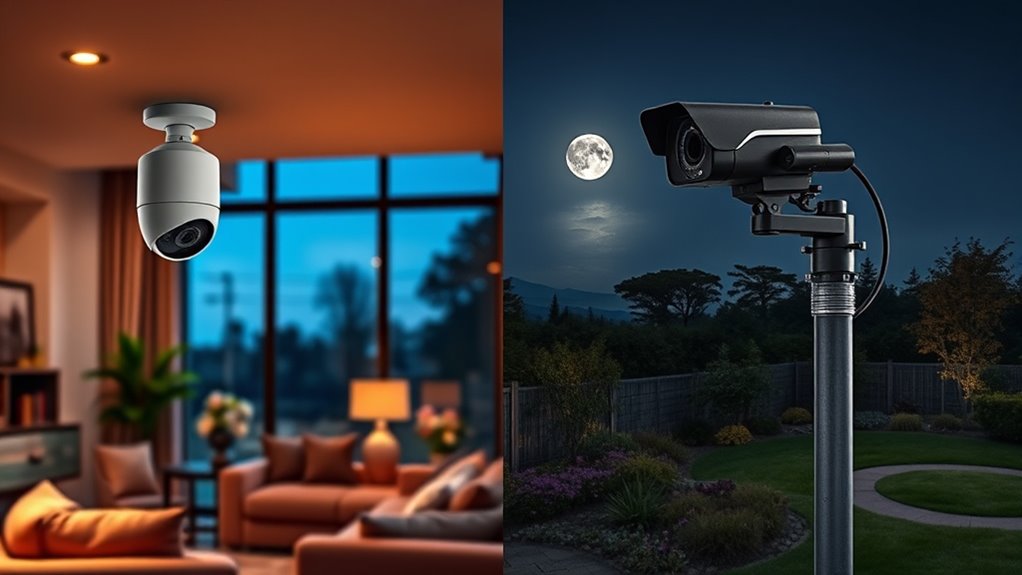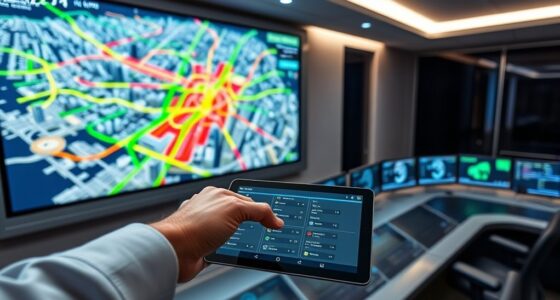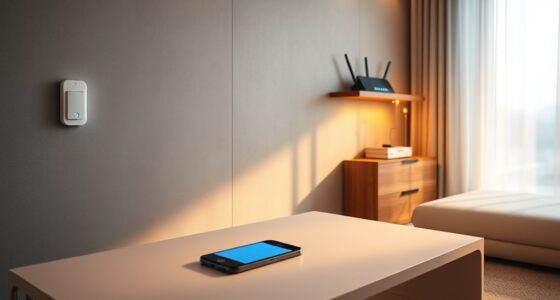Indoor and outdoor security cameras differ mainly in design, materials, and durability. Indoor models use lightweight, impact-resistant plastics and focus on features like wide-angle lenses and smart detection, while outdoor cameras are housed in tough, weatherproof enclosures made from stainless steel, aluminum, or reinforced plastics with high IP ratings. Outdoor setups need regular maintenance to stay effective against weather, dust, and vandalism. Continue exploring to understand how each type suits your security needs best.
Key Takeaways
- Indoor cameras use lightweight, impact-resistant plastics and focus on smart features, while outdoor cameras have weatherproof housings made from durable metals or reinforced plastics.
- Outdoor cameras are rated with IP66/IP67/IP68 for dust and water resistance, suitable for harsh environments; indoor cameras lack such ratings.
- Placement differs: indoor cameras are installed at 8-10 feet for interior coverage; outdoor cameras are mounted to cover perimeters and vulnerable entry points.
- Outdoor models emphasize weather resistance, vandal-proof design, night vision, and high durability; indoor models prioritize aesthetics, discreetness, and smart detection features.
- Indoor cameras monitor internal activity for safety and valuables, whereas outdoor cameras deter intruders and secure external property.
Design and Construction Materials
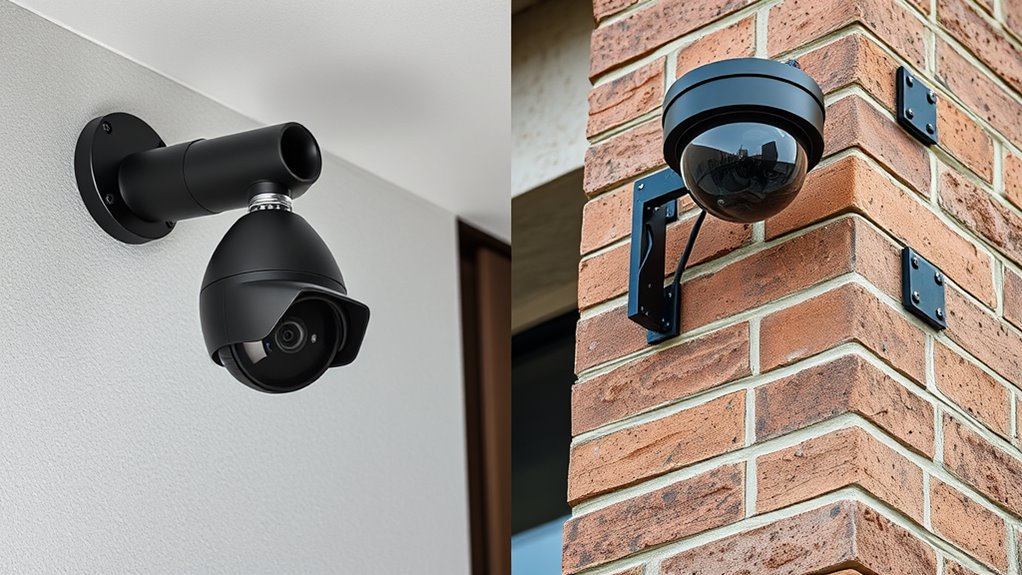
Indoor security cameras are usually built with lightweight plastic housings that are easy to install and blend into your home’s decor. Their design focuses on sleek, discreet shapes like domes or cubes, making sure they don’t stand out. Construction materials prioritize material quality, utilizing impact-resistant plastics that can withstand minor bumps. These cameras often feature durable, weatherproof coatings, although weatherproofing isn’t their primary concern. The plastic housings are designed for environmental resistance within indoor environments, providing a good balance of durability and aesthetics. By choosing high-quality plastics and thoughtful design, manufacturers create cameras that are lightweight yet sturdy enough for indoor use. The emphasis on impact resistance ensures your cameras stay protected from accidental bumps, keeping your surveillance system reliable and unobtrusive. Additionally, selecting impact-resistant plastics enhances the longevity and robustness of the cameras in everyday indoor settings. Incorporating environmental resistance features helps maintain performance despite exposure to indoor conditions like humidity and temperature fluctuations. This focus on material quality ensures that the cameras remain durable over time even with regular use. Moreover, advancements in plastic technology have allowed for even more sophisticated and resilient camera housings, further improving performance and safety. Recognizing the importance of integrated AI features, many modern indoor cameras also include smart detection capabilities to alert you to unusual activity.
Weather Resistance and Durability

When choosing outdoor security cameras, you’ll want to pay attention to their weatherproof ratings like IP66 or IP67, which guarantee they can handle dust and rain. The materials used, such as stainless steel or reinforced plastics, also play a vital role in withstanding extreme temperatures and impacts. Regular maintenance guarantees your cameras stay durable and perform reliably over time, even in harsh conditions. Additionally, selecting cameras with proper sunscreen formulations can help protect their electronic components from sun damage and overheating. Implementing proper installation techniques ensures that weather resistance is maintained and that the cameras remain secure against environmental factors, minimizing the risk of water ingress or damage. Proper annual inspections can further enhance longevity by identifying and addressing potential vulnerabilities early. Furthermore, considering AI-driven diagnostics can assist in predictive maintenance, helping detect issues before they lead to failure.
Weatherproof Ratings (IP Codes)
Have you ever wondered how outdoor security cameras withstand harsh weather conditions? It’s all about IP ratings, which specify a camera’s weatherproof capabilities through ingress protection levels. Outdoor cameras typically feature IP66, IP67, or IP68 ratings, making them dust-proof and waterproof. An IP66 rating means your camera is protected against dust and can resist powerful water jets, perfect for outdoor use. IP67 offers even better protection, allowing the camera to withstand immersion in water up to 1 meter for 30 minutes. IP68 takes it further, enabling continuous immersion under specific conditions. Weatherproof ratings are crucial for ensuring your camera’s longevity in challenging environments. Additionally, the construction quality of a camera can influence its ability to withstand extreme weather, emphasizing the importance of choosing a durable model. Proper sealing and rugged materials further enhance weather resistance, making your security system more reliable over time. Understanding Ingress Protection (IP) ratings can help you select a camera suited for your specific outdoor conditions. Moreover, regular maintenance and inspections can help identify potential vulnerabilities before they compromise your camera’s weatherproof integrity.
Material and Housing Strength
Outdoor security cameras are built with tough, weatherproof housings made from materials like stainless steel, aluminum, or reinforced plastics to handle rain, snow, dust, and extreme temperatures. These outdoor camera materials guarantee high housing durability through weatherproof housings and reinforced casings. They often feature high IP ratings—such as IP66, IP67, or IP68—that guarantee resistance to water, dust, and solid particles, maintaining reliable operation. The material strength of these tamper-resistant enclosures and vandal-proof designs prevents damage and theft. While outdoor camera housings focus on durability, indoor camera aesthetics prioritize lightweight plastics and sleek designs. Overall, the use of durable materials and reinforced casings contributes considerably to outdoor camera longevity, ensuring they withstand harsh environmental conditions without compromising performance. Additionally, the material quality used in manufacturing ensures long-term resistance to corrosion and environmental wear, which is essential for maintaining performance reliability over time. Incorporating weather-resistant materials further enhances the camera’s capacity to operate effectively in diverse climates, safeguarding against environmental damage. The design features of outdoor cameras often include secure mounting options and tamper detection to enhance their resilience.
Maintenance and Longevity
To guarantee your outdoor security cameras last and perform reliably, regular maintenance is essential. Their weatherproof ratings, like IP66 or IP67, ensure they resist dust, rain, snow, and extreme temperatures, boosting their durability. Constructed from materials such as stainless steel, aluminum, or reinforced plastics, outdoor cameras are designed to withstand environmental stresses, extending their lifespan. Proper upkeep involves cleaning lenses, inspecting weatherproof seals, and checking for corrosion or damage. This maintenance helps preserve their weather resistance and overall performance. Unlike indoor cameras, outdoor models are built for longevity, but neglecting maintenance can reduce their effectiveness and lifespan. Investing time in regular care keeps your outdoor cameras resilient against the elements, ensuring they continue to protect you for years to come.
Placement Strategies and Coverage Areas
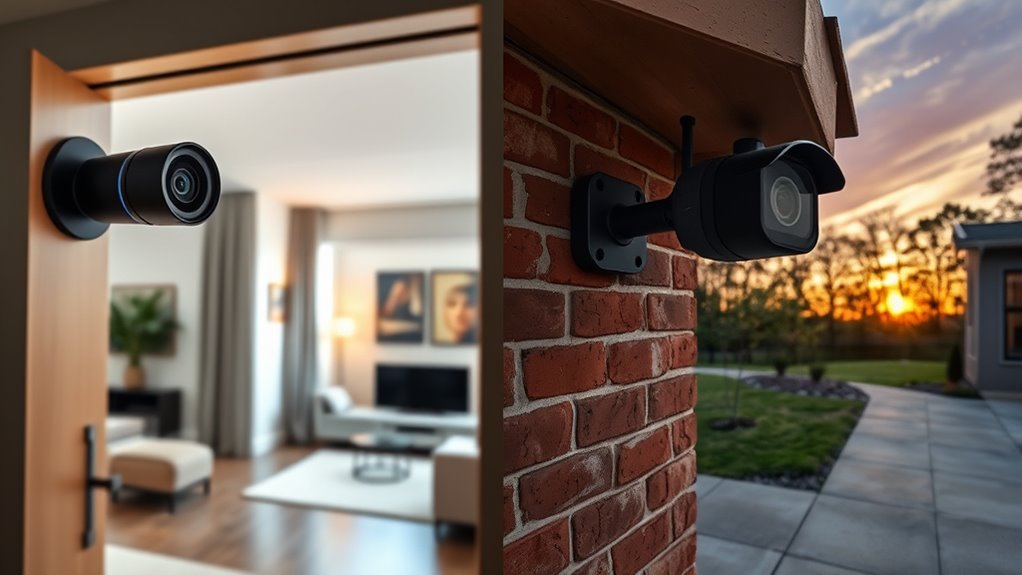
To get the most out of your security cameras, you need to think carefully about their placement and coverage areas. Focus on key entry points like doors and driveways, and position cameras to avoid blind spots by using multiple angles. Balancing indoor and outdoor coverage guarantees your entire property stays protected, day and night.
Optimal Camera Placement
Effective camera placement is essential for maximizing security coverage and minimizing blind spots. To achieve this, focus on strategic positioning that optimizes the camera’s field of view and coverage areas. Consider these key points:
- Mount cameras at appropriate heights and angles to cover high-traffic zones or entry points effectively.
- Avoid glare and reflections by facing cameras away from direct sunlight and reflective surfaces.
- Account for lighting conditions, ensuring outdoor cameras have night vision capabilities for nighttime visibility.
- Protect cameras from environmental challenges and tampering by placing them in secure, elevated locations.
Coverage of Entry Points
Where should you focus your security camera placement to best protect your home? Both indoor and outdoor cameras should target entry points to ensure thorough coverage. Indoor cameras are ideal at main entry points like front doors and hallways, providing visibility of internal activity. Outdoor cameras should be strategically placed at vulnerable points such as driveways, garage entrances, and perimeter fences to monitor perimeter security. Proper camera positioning at heights of 8-10 feet helps maximize coverage and reduce tampering. This setup minimizes blind spots, especially around side and back entrances, preventing gaps in your security. Combining indoor and outdoor placements creates a layered approach, covering both interior and exterior entry points and safeguarding your home’s vulnerable points effectively.
Balancing Indoor, Outdoor
How can you effectively balance indoor and outdoor camera placements to maximize your home’s security? First, identify your coverage areas: indoor cameras should monitor high-traffic zones like hallways and living rooms, while outdoor cameras focus on perimeter entry points and driveways. Second, consider environmental conditions for outdoor cameras, choosing weather-resistant types and avoiding glare from direct sunlight. Third, apply proper installation practices—mount cameras at vantage points that optimize visibility and reduce tampering risks. Fourth, align camera types with your specific security needs, combining indoor surveillance with external monitoring for exhaustive coverage. Balancing these placement strategies ensures you cover both internal activities and external vulnerabilities, creating a seamless security system that adapts to your environment.
Features and Functional Capabilities
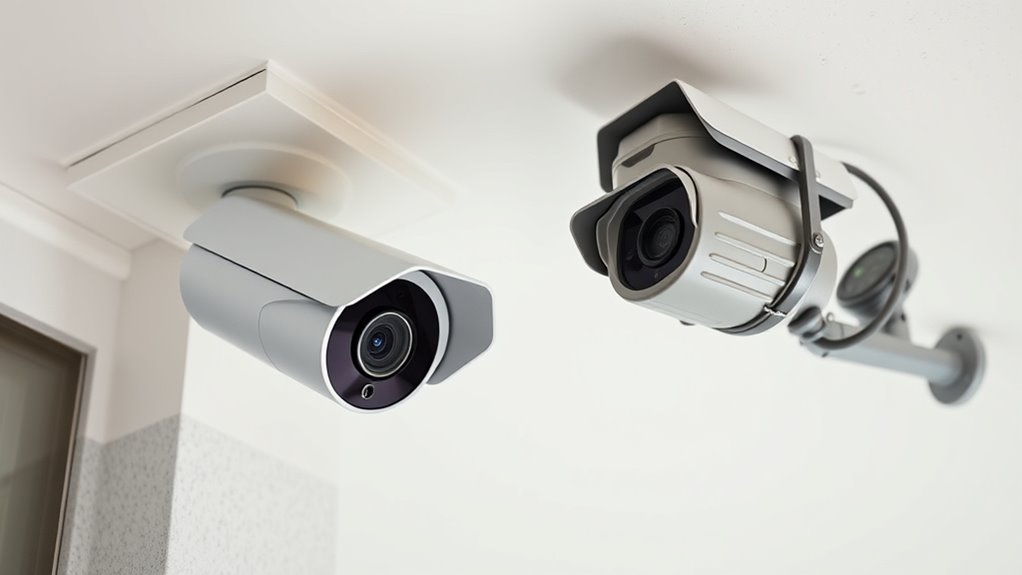
Home security cameras come equipped with a variety of features designed to enhance your safety and convenience. Indoor security cameras often feature wide-angle lenses and two-way audio, making monitoring and communication simple. Outdoor security cameras are built with weatherproof housings rated at IP66 or higher, ensuring durability against rain, dust, and extreme temperatures. Many outdoor models include night vision and enhanced resolution for clear footage in darkness, crucial for 24/7 surveillance. Both types generally offer motion detection capabilities, but outdoor cameras often add tamper resistance and vandal-proof designs for added security. While indoor cameras focus on discreet design and smart camera features, outdoor cameras emphasize environmental resilience and ruggedness, ensuring reliable performance regardless of weather or environmental conditions.
Privacy and Security Considerations
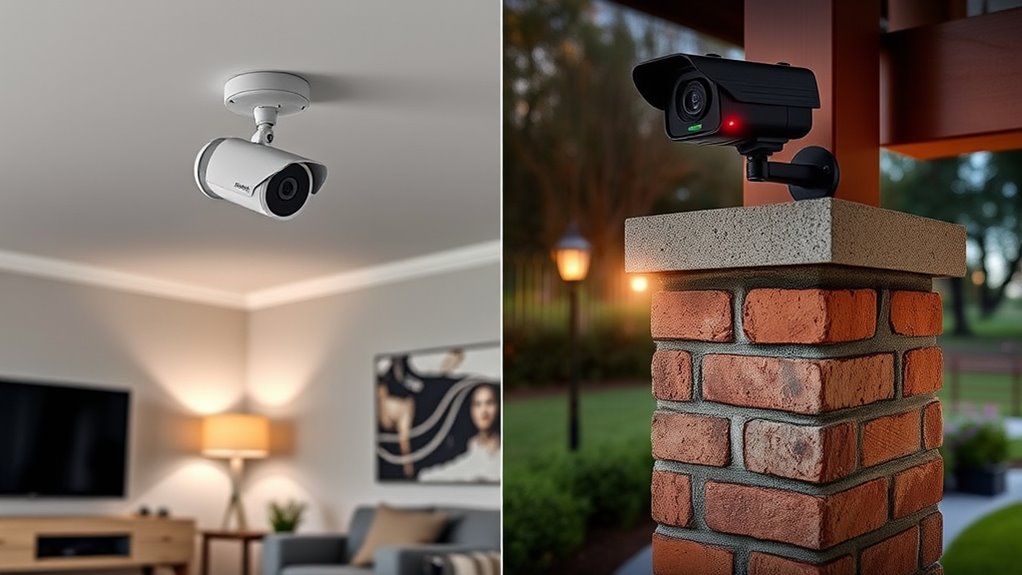
While security cameras enhance your ability to monitor and protect your property, addressing privacy concerns is equally important. To do so, consider these key points:
- Proper camera placement ensures you avoid capturing neighbors’ property and respect privacy rights.
- Indoor cameras should use privacy zones and masking features to block sensitive areas like bedrooms and bathrooms.
- Outdoor cameras must comply with surveillance laws, including clear signage and disclosure when monitoring public or semi-public spaces.
- Staying aware of legal considerations helps you implement privacy measures that prevent violations and potential litigation.
Balancing security with privacy requires understanding privacy and security considerations, ensuring your setup aligns with legal standards and respects everyone’s rights.
Power Options and Connectivity
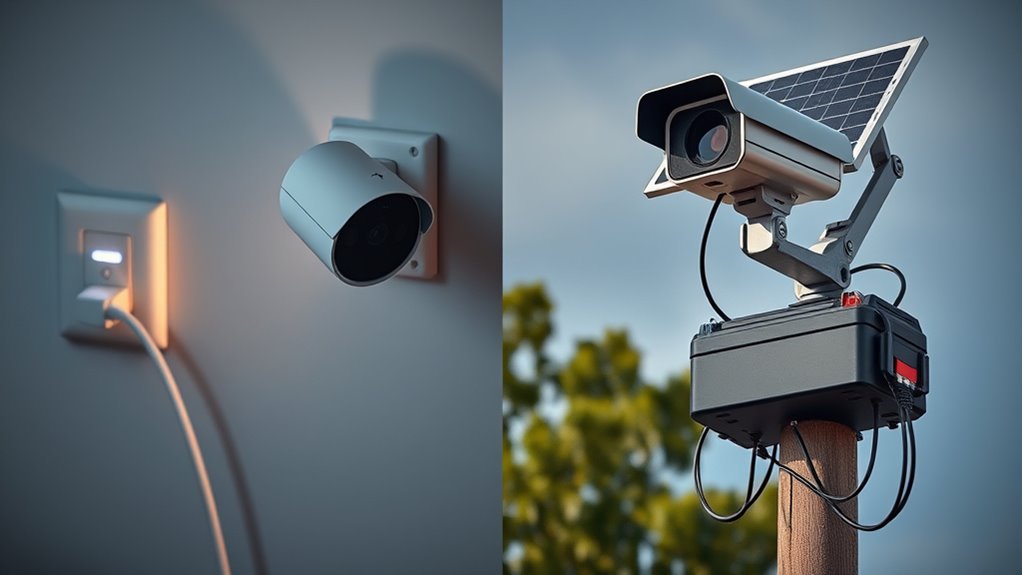
Choosing the right power options and connectivity methods is vital for ensuring your security cameras operate reliably. Many outdoor cameras support Power over Ethernet (PoE), combining power and data through a single cable for easier installation. Backup power options like rechargeable batteries or solar panels help keep cameras active during outages. For connectivity, you can choose wired Ethernet, Wi-Fi signals, or cellular networks, depending on your location. Wireless cameras offer flexible placement but may need signal boosters for ideal Wi-Fi performance. Some models provide dual power options, letting you switch between wired power and battery, reducing downtime. Ensuring strong cellular or Wi-Fi signals is essential for seamless live feeds and alerts, especially in remote areas.
Common Use Cases and Deterrence
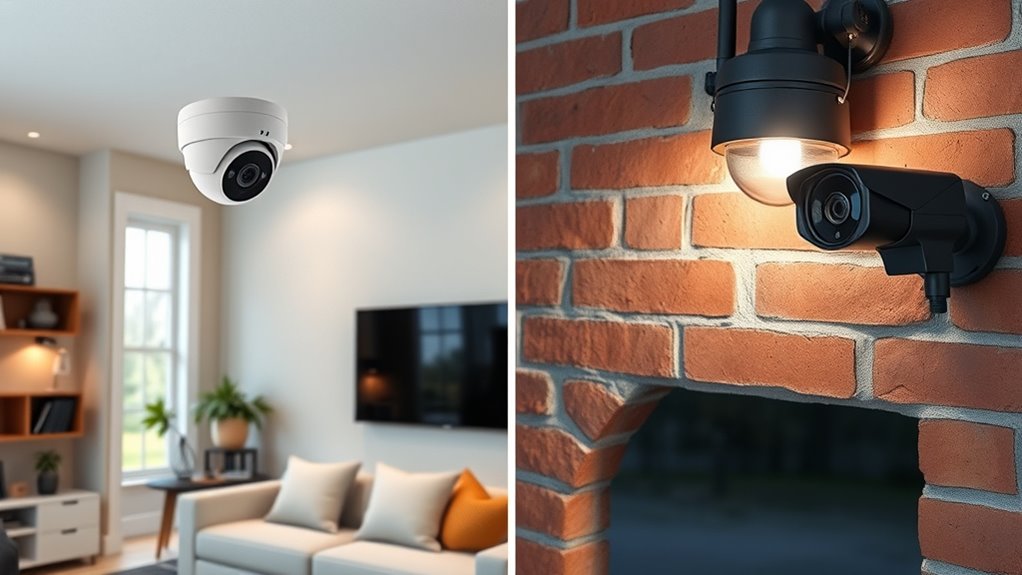
Indoor cameras are vital for monitoring valuables, children, and pets inside your home, providing peace of mind and quick access to live footage. They help detect unauthorized access and guarantee indoor security. Outdoor cameras act as strong visual deterrents by their visible presence, discouraging suspicious activity and potential intruders. Their deterrent effect is amplified with features like motion detection and audible alarms. To maximize security, consider these use cases:
- Using indoor cameras for real-time monitoring of kids and pets.
- Placing outdoor security cameras at entry points to prevent intrusion.
- Employing visible outdoor cameras as a deterrent against break-ins.
- Relying on motion detection alerts to respond quickly to suspicious activity.
Both indoor and outdoor cameras serve vital roles in intrusion prevention, with their presence working as key visual deterrents to potential threats.
Installation and Maintenance Tips
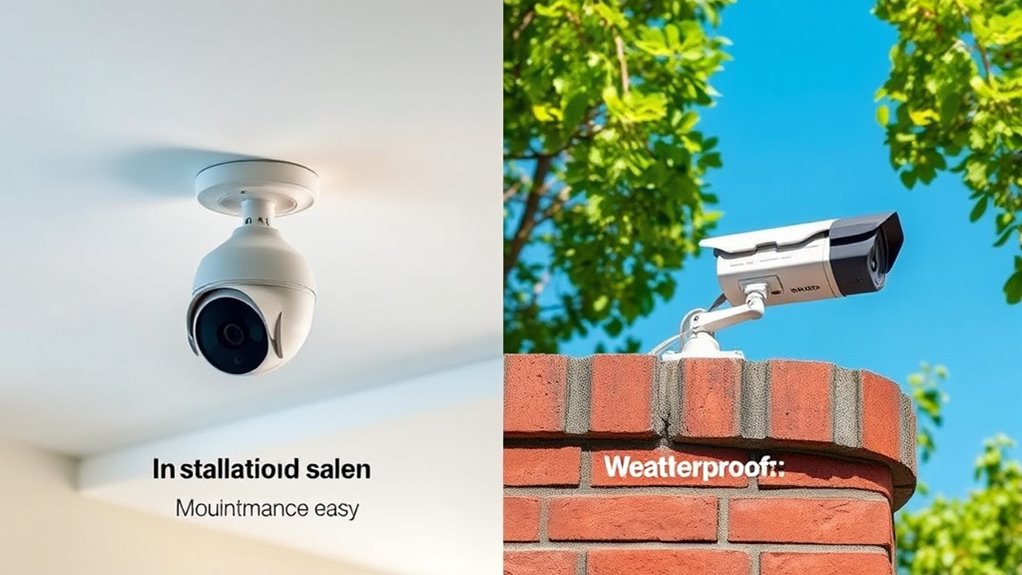
Proper installation and ongoing maintenance are key to ensuring your security cameras operate effectively. For installation, carefully choose placement—high-traffic indoor areas or protected outdoor spots away from direct weather exposure. Mounting should be secure, with outdoor cameras weatherproofed to withstand elements, while indoor cameras need minimal wiring, often using plug-in or USB power sources. Regular maintenance includes cleaning lenses to ensure clear footage and inspecting weatherproof seals and mounting hardware. Check power sources and network connections regularly, especially after severe weather. Keep firmware updated to maintain security and performance. For outdoor cameras, ensure weatherproofing measures are intact, and for indoor cameras, verify placement to maximize coverage without invading privacy. Proper installation and maintenance safeguard your security system’s reliability.
Choosing the Right Camera for Your Environment
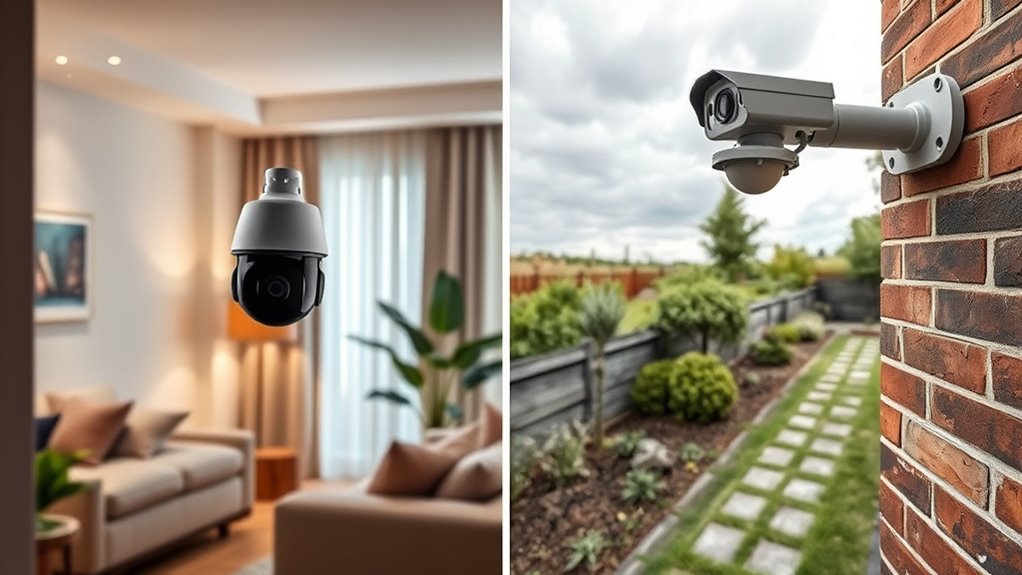
Selecting the right security camera depends on your environment and specific surveillance needs. For indoor cameras, focus on discreet designs, wide-angle lenses, and features like two-way audio to monitor indoor spaces effectively. Outdoor cameras require weatherproof ratings like IP66 or higher, durable materials, and tamper resistance to withstand environmental factors such as rain, snow, and dust. Proper placement is essential; position outdoor cameras at secure heights away from direct sunlight, while indoor cameras should be placed at high-traffic or entry points for maximum coverage. Consider lighting conditions—night vision capabilities are indispensable outdoors. Ultimately, choosing between indoor cameras and outdoor cameras depends on factors like durability, environmental exposure, and camera features to guarantee comprehensive surveillance coverage.
Frequently Asked Questions
What Is the Difference Between Indoor and Outdoor Security Cameras?
You want to know the difference between indoor and outdoor security cameras. Indoor cameras are small, lightweight, and designed to blend into your home decor, monitoring interior spaces like hallways and valuables. Outdoor cameras are built tough with weatherproof materials, covering perimeter areas and entry points. They’re more visible, act as deterrents, and resist elements like rain and dust, ensuring reliable security outside your home.
Can an Indoor Security Camera Be Used Outdoors?
Using an indoor security camera outdoors is like trying to wear a raincoat in a hurricane—it’s not designed for it. Most indoor cameras aren’t weatherproof and lack the necessary ratings, so exposure to rain or snow can damage them, void warranties, and reduce effectiveness. If you want outdoor surveillance, pick a camera rated for outdoor use or place an indoor model inside a weatherproof enclosure for protection.
Is It Better to Have Cameras Inside or Outside?
You wonder whether it’s better to have cameras inside or outside. It depends on your security needs. Indoor cameras are great for monitoring valuables and family activity, while outdoor cameras help deter intruders and protect entry points. Installing both offers extensive coverage, but if you must choose, consider your main concerns—whether it’s internal safety or perimeter protection—and select accordingly for the best security.
What Type of Security Camera Is Best for Home?
You want the best security camera for your home, so consider your specific needs. Indoor cameras are perfect for monitoring entry points and valuables inside, offering clear images and two-way audio. Outdoor cameras are weatherproof and great for perimeter surveillance, acting as deterrents. Ideally, use a combination of both to guarantee thorough coverage. Think about environmental factors, night vision, and tamper resistance to choose the right cameras that fit your lifestyle.
Conclusion
Choosing the right security camera means envisioning your home as a fortress of safety. Indoor cameras blend seamlessly into your living space, while outdoor ones stand guard against the night’s shadows. By understanding their differences, you create a vigilant eye watching over your loved ones and valuables. Imagine a quiet sentinel, ever-watchful, nestled in the corner—your peace of mind secured, day and night. Make the right choice and feel confident your home is protected from every angle.
